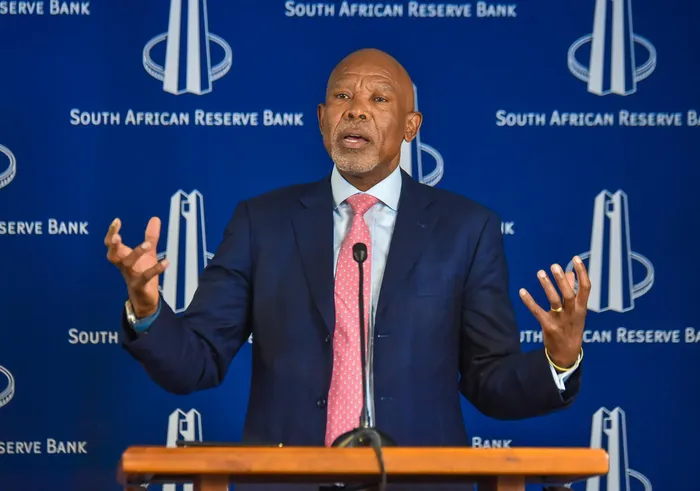Kganyago says SA entering a ‘low-inflation era’ as Treasury moves to formalise lower target
MONETARY POLICY

Kganyago said South Africa’s inflation outlook has now stabilised, with the bank projecting inflation to average 3.4% in 2025, 3.6% in 2026, and 3% by 2027.
Image: SARB | Facebook
South African Reserve Bank (Sarb) Governor Lesetja Kganyago said on Tuesday that the country has entered an era of “low and stable inflation” and confirmed that discussions with the National Treasury are at an advanced stage to formally lower South Africa’s inflation target.
Speaking at the SA Tomorrow Investment Conference 2025, Kganyago said a joint statement by the Sarb and the Treasury had already been issued following their meeting with the Fiscal and Monetary Policy Commission, and that a formal announcement would be made “as soon as it is politically possible.”
“It was important that the joint team of the Treasury and the Reserve Bank be given time to tie the loose ends before a formal announcement could be made,” Kganyago said.
The governor traced South Africa’s disinflation journey, explaining that inflation expectations, once anchored around 6.1–6.2%, had gradually shifted toward the midpoint of the target range (4.5%) after the Sarb formally adopted that focus in 2017.
“In 2017, we decided to aim for the middle of the target range—4.5%. By 2019, inflation expectations had converged toward that midpoint,” he said.
However, as inflation fell sharply after the global inflation surge of 2022, the Sarb took what Kganyago called an “opportunistic disinflation” approach.
“Inflation dropped to 3%, then 2.9%, and we decided to take advantage of this environment by expressing a preference for inflation at the lower end of the range,” Kganyago said.
“In May, we presented a scenario of a 3% target, and by July, we confirmed that 4.5% would serve as the reference scenario as we transition toward that lower level.”
Kganyago said South Africa’s inflation outlook has now stabilised, with the bank projecting inflation to average 3.4% in 2025, 3.6% in 2026, and 3% by 2027.
“That should help shape inflation expectations further downward,” he said.
Turning to food inflation, Kganyago said agricultural data indicated a continuing moderation in food price pressures, with cereal and crop prices falling and the effects of livestock disease disruptions easing.
“The crop estimates show prices are coming down,” he said. “Food inflation has already dropped from 5.9% to 5.4%, and we believe that trend will continue.”
Kganyago also linked the country’s declining risk premium to improved fiscal discipline and the prospect of a lower inflation target.
“The biggest determinant of the country risk premium is fiscal risk,” he said. “The Treasury has now recorded two consecutive years of primary surplus, which is positive for fiscal consolidation. Together with our disinflation efforts, this contributes to lowering borrowing costs.”
On U.S. tariffs, Kganyago warned that new trade barriers — including potential restrictions on Agoa exports — could shave 0.3 percentage points off South Africa’s GDP growth this year, with particularly severe effects on the automotive and agriculture sectors.
“For an economy growing at 1.2%, that’s not a small number,” he cautioned. “The Eastern Cape will be especially affected, as it depends heavily on the automotive industry. Our citrus and nut exports will also suffer.”
Meanwhile, JSE CEO Leila Fourie hailed the return of investor confidence and reform momentum in South Africa, saying that “conviction is returning to the country’s markets” as structural reforms begin to translate into tangible economic gains.
Speaking at the same conference, Fourie said South Africa’s markets had been among the world’s strongest performers over the past year, buoyed by improving macroeconomic stability and progress on key government reforms.
“Since the formation of the Government of National Unity last year, the FTSE JSE Top 40 has climbed roughly 55% in US dollar terms,” Fourie noted.
“That’s ahead of the MSCI Emerging Markets Index, which is up 28%, the MSCI World, up 27%, and even the NASDAQ 100, which has risen 41%. The JSE’s own share price has increased more than 60% in dollar terms.”
Fourie added that the total market capitalisation of JSE-listed companies has grown by 17% year to date, underscoring renewed investor optimism.
“Investors with capital at risk are voting with their wallets,” she said. “Macroeconomic foundations are stabilising — inflation remains anchored, fiscal consolidation is holding, energy availability has improved, and logistics reforms are taking hold,” she said.
While acknowledging that growth remains modest and unemployment “unacceptably high,” she said the market is “recalibrating for the growth that’s coming, underpinned by resilient institutions and reforms that are compounding.”
Fourie praised the growing collaboration between business and government through initiatives such as Operation Vulindlela and ongoing macroeconomic dialogues.
“The JSE is working with partners at home and abroad to align market practice with national reform — in ports, rail, energy, credit infrastructure, and capital creation,” she said.
BUSINESS REPORT